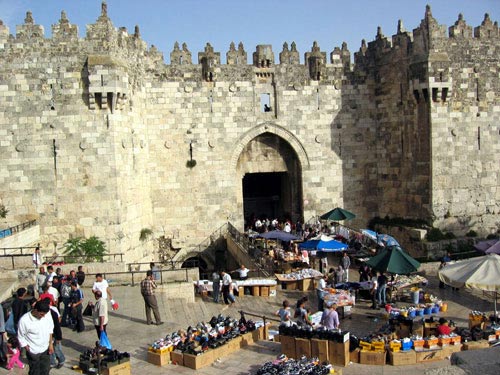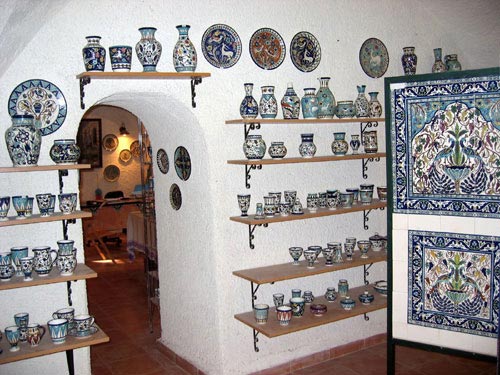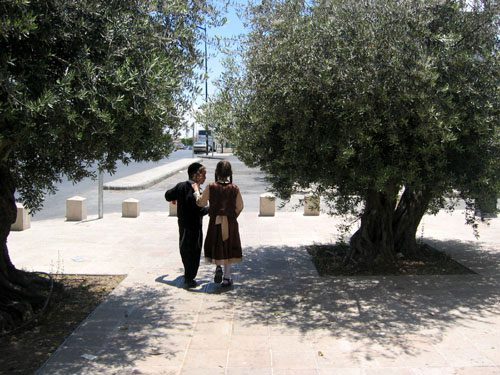
Ultra-orthodox Jewish kids on their way home
The Olive Tree Hotel is located near the ultra-orthodox neighborhood of Mea Shearim. This photo was taken by the Museum of the Seam.
The Olive Tree Hotel is located near the ultra-orthodox neighborhood of Mea Shearim. This photo was taken by the Museum of the Seam.
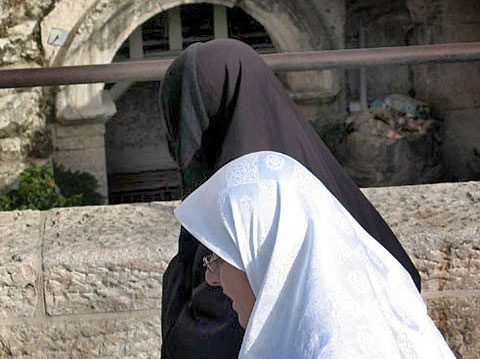
Ancient Roman Gate
Located below and to the left of the Damascus Gate, the Ancient Roman Gate is part of a triple gate entrance to the Roman city of Aelia Capitolina, which is at least 1800 years old, possibly 2000 years old. The tower features typical Herodian carvings.
Located below and to the left of the Damascus Gate, the Ancient Roman Gate is part of a triple gate entrance to the Roman city of Aelia Capitolina, which is at least 1800 years old, possibly 2000 years old. The tower features typical Herodian carvings.

Tomb of Simon the Just (Shimon HaZaddik)
Legend has it that Alexander the Great, determined to destroy the temple, was greeted by Simon the Just, High Priest of the Jewish Temple, in 312 BC. As a result of recognizing the High Priest as the figure in his dreams who had appeared as an omen of victory before every battle, Alexander unexpectedly bowed down before him. When visiting this site women should wear modest clothing and men should cover their heads.
Legend has it that Alexander the Great, determined to destroy the temple, was greeted by Simon the Just, High Priest of the Jewish Temple, in 312 BC. As a result of recognizing the High Priest as the figure in his dreams who had appeared as an omen of victory before every battle, Alexander unexpectedly bowed down before him. When visiting this site women should wear modest clothing and men should cover their heads.
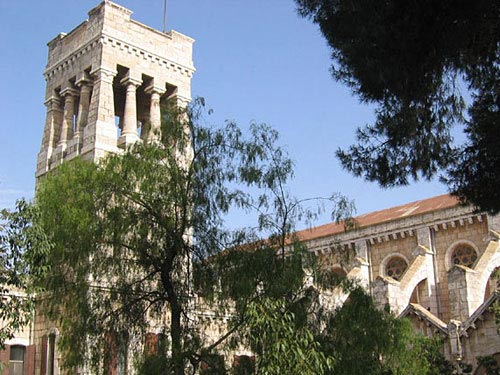
Ecole Biblique
This church was dedicated to St. Stephen in 460 AD by Empress Eudocia after she was banished by her husband to Jerusalem. Below the church, fifteen extraordinary tombs were discovered near the graves of some of the greatest Holy Land scholars, including Fathers Vincent, de Vaux, Benoit and Felix Abel.
This church was dedicated to St. Stephen in 460 AD by Empress Eudocia after she was banished by her husband to Jerusalem. Below the church, fifteen extraordinary tombs were discovered near the graves of some of the greatest Holy Land scholars, including Fathers Vincent, de Vaux, Benoit and Felix Abel.
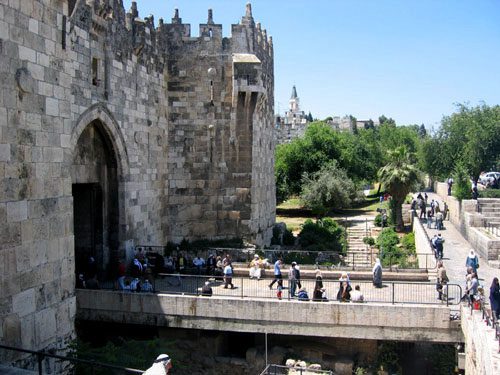
Damascus Gate
Located next to the famous open-air marketplace, this is one of the main gates into the Old City. Below the gate archaeologists discovered an ancient Roman or Herodian gate. In Hebrew, the Damascus Gate is known as Shaar Shechem, and in Arabic, Bab el-Amud.
Located next to the famous open-air marketplace, this is one of the main gates into the Old City. Below the gate archaeologists discovered an ancient Roman or Herodian gate. In Hebrew, the Damascus Gate is known as Shaar Shechem, and in Arabic, Bab el-Amud.
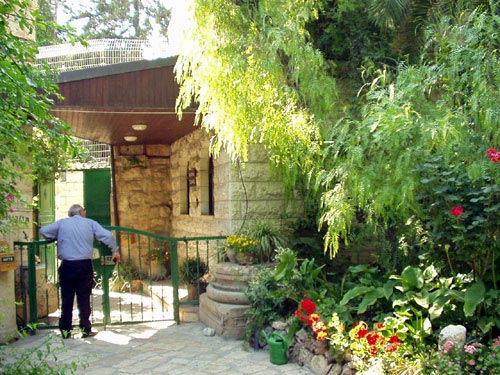
Entrance to the Garden Tomb
The Garden Tomb was discovered in 1867 and is believed to contain the tomb where Jesus was buried by Joseph of Arimathea. The hotel reception desk staff would be happy to check the Garden Tomb’s opening hours if you would like to visit.
The Garden Tomb was discovered in 1867 and is believed to contain the tomb where Jesus was buried by Joseph of Arimathea. The hotel reception desk staff would be happy to check the Garden Tomb’s opening hours if you would like to visit.
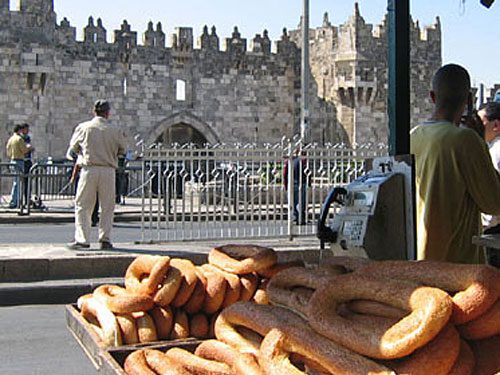
“Bagele” topped with sesame seeds
“Bagele” topped with sesame seeds
“Bagele” topped with sesame seeds
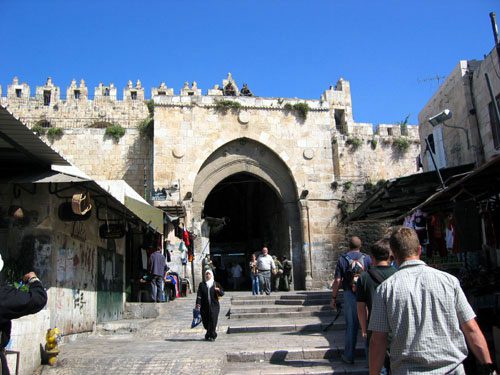
Explore the Old City
No visit to Jerusalem is complete without a wander along the cobbled alleys of the Old City. Here you can fathom at the hustle and bustle and wonder how the locals go about their everyday business so normally in what is such an intense place. Kids play in the street, men sitting in cafes smoking nargilas (hookahs), people hurrying to their places of worship and of course this is a great place to purchase unique souvenirs from this special city.
No visit to Jerusalem is complete without a wander along the cobbled alleys of the Old City. Here you can fathom at the hustle and bustle and wonder how the locals go about their everyday business so normally in what is such an intense place. Kids play in the street, men sitting in cafes smoking nargilas (hookahs), people hurrying to their places of worship and of course this is a great place to purchase unique souvenirs from this special city.
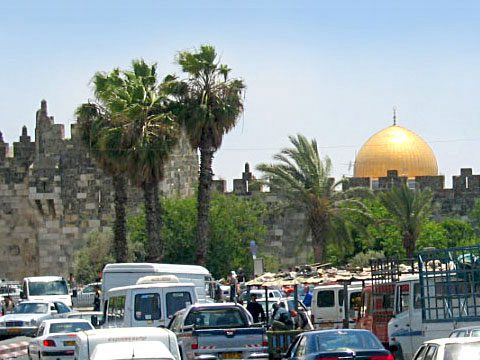
Temple Mount And Dome Of The Rock
When visiting Jerusalem, many people want to see the Temple Mount and the Dome of the Rock. The Temple Mount is a holy site within the Old City of Jerusalem for Jewish, Christian, and Muslim people. All visitors are able to tour the compound and the Al-Aqsa Mosque, with the exception of the Dome of the Rock. Seen as the holiest site for Jewish believers, parts of the four walls surrounding the Temple Mount date back to the time of the Second Jewish Temple, in the first century BCE. The walls were built around the summit of Mount Moriah. Biblically, this is where Abraham offered his son Isaac as a sacrifice.
The Temple Mount is the third holiest site for Muslims after Mecca and Medina. Alongside the Abrahamic history of the site, in Muslim tradition, this is where the Prophet Mohammed made his “Night Journey” to the throne of God.
When visiting Jerusalem, many people want to see the Temple Mount and the Dome of the Rock. The Temple Mount is a holy site within the Old City of Jerusalem for Jewish, Christian, and Muslim people. All visitors are able to tour the compound and the Al-Aqsa Mosque, with the exception of the Dome of the Rock. Seen as the holiest site for Jewish believers, parts of the four walls surrounding the Temple Mount date back to the time of the Second Jewish Temple, in the first century BCE. The walls were built around the summit of Mount Moriah. Biblically, this is where Abraham offered his son Isaac as a sacrifice.
The Temple Mount is the third holiest site for Muslims after Mecca and Medina. Alongside the Abrahamic history of the site, in Muslim tradition, this is where the Prophet Mohammed made his “Night Journey” to the throne of God.
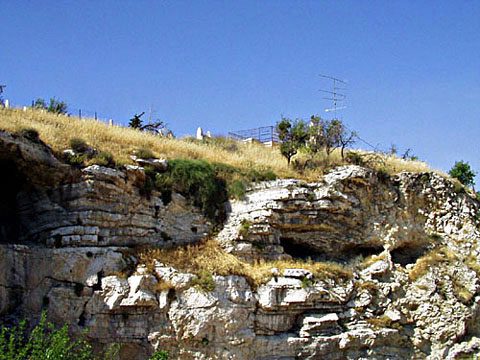
Gordon’s Calvary
Charles “Chinese” Gordon drew the distinction in 1884 of Golgotha being the “place of the skull,” where Jesus was crucified. Garden Tomb offers the best view of Gordon’s Calvary. The hotel reception desk will happily inform you of the current opening hours for Gordon’s Calvary if you wish to visit.
Charles “Chinese” Gordon drew the distinction in 1884 of Golgotha being the “place of the skull,” where Jesus was crucified. Garden Tomb offers the best view of Gordon’s Calvary. The hotel reception desk will happily inform you of the current opening hours for Gordon’s Calvary if you wish to visit.
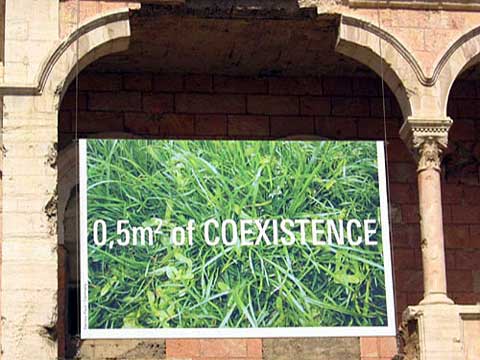
Museum on the Seam
Located on a seam that used to divide east and west Jerusalem, its name stems from its geographic location. Visitors are propelled to participate actively in building a reality in which diverse ideas, opinions, and values can coexist.
Located on a seam that used to divide east and west Jerusalem, its name stems from its geographic location. Visitors are propelled to participate actively in building a reality in which diverse ideas, opinions, and values can coexist.
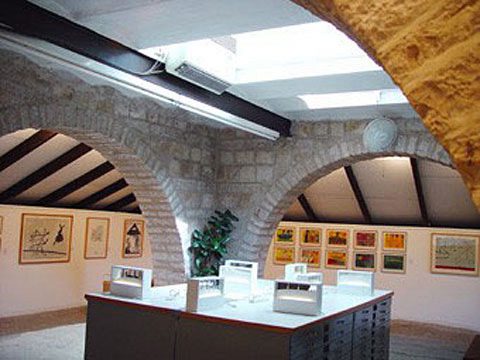
Jerusalem Print Workshop
The Jerusalem Print Workshop is Israel’s most prolific art print producer, with 5 etching presses, 3 lithograph presses, 6 letterpresses, and 2 silk screening presses. The loft gallery is open to visitors. A new exhibition is displayed every few months.
The Jerusalem Print Workshop is Israel’s most prolific art print producer, with 5 etching presses, 3 lithograph presses, 6 letterpresses, and 2 silk screening presses. The loft gallery is open to visitors. A new exhibition is displayed every few months.
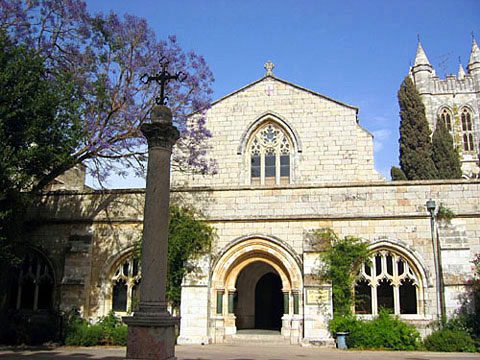
St George Cathedral
St. George’s Cathedral is an Anglican (Episcopal) cathedral and is the seat of the Episcopal Bishop of Jerusalem. A two-hundred-yard walk will lead you to the Garden Tomb at 20 Nablus Road.
St. George’s Cathedral is an Anglican (Episcopal) cathedral and is the seat of the Episcopal Bishop of Jerusalem. A two-hundred-yard walk will lead you to the Garden Tomb at 20 Nablus Road.
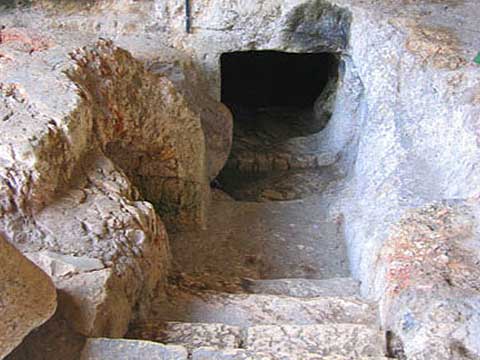
Tomb of the Kings
A well-preserved frieze adorns this tomb complex dating from the first century AD. The original rolling stone, which once blocked the entrance, is still visible. Located on 46 Saladin Street. If you are an archeology buff, don’t miss it!
A well-preserved frieze adorns this tomb complex dating from the first century AD. The original rolling stone, which once blocked the entrance, is still visible. Located on 46 Saladin Street. If you are an archeology buff, don’t miss it!
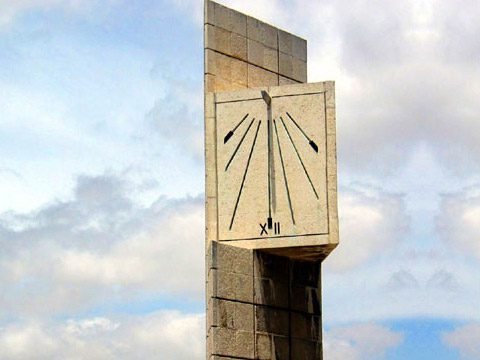
Sundial Sculpture
An unusual sundial sculpture can be found on Route 1 on the side of the road. In order for the sundial to function, it must be directly illuminated by the sun. As soon as the sun is obscured by clouds, the sundial ceases to function. Remember to bring your watch with you, otherwise you might not be able to determine the correct time.
An unusual sundial sculpture can be found on Route 1 on the side of the road. In order for the sundial to function, it must be directly illuminated by the sun. As soon as the sun is obscured by clouds, the sundial ceases to function. Remember to bring your watch with you, otherwise you might not be able to determine the correct time.

